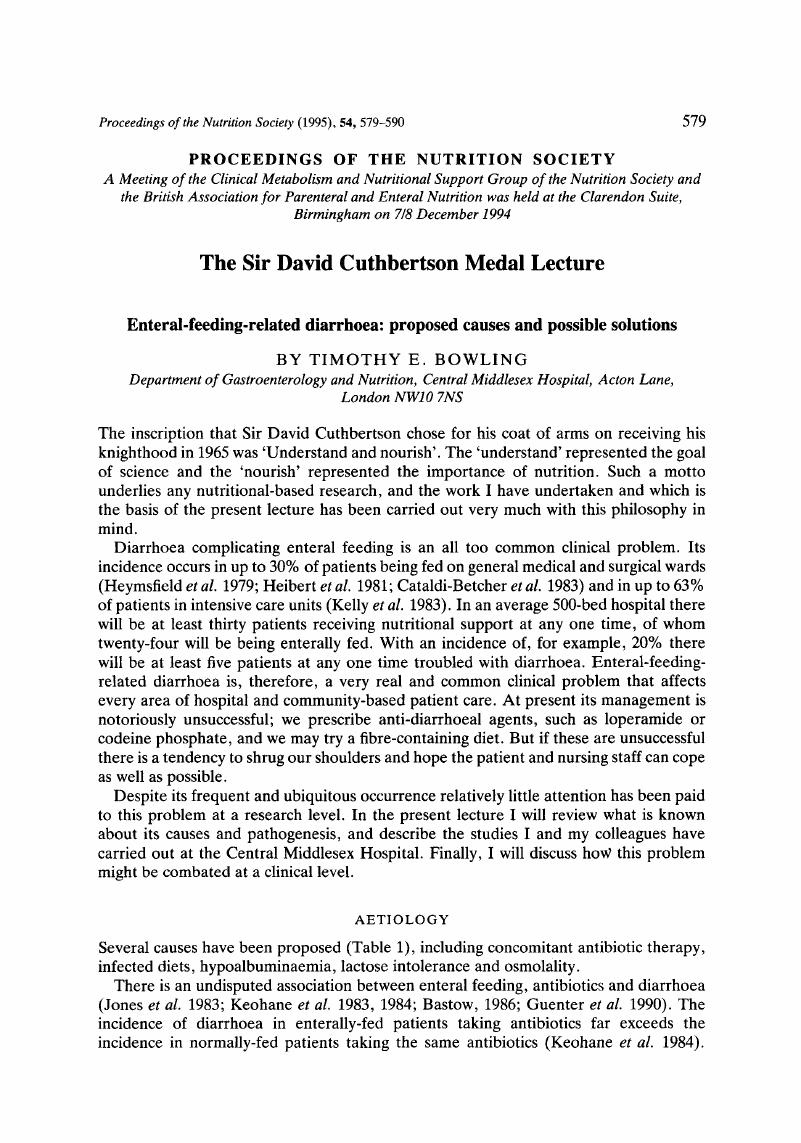Crossref Citations
This article has been cited by the following publications. This list is generated based on data provided by Crossref.
DeMeo, Mark
Kolli, Srinivas
Keshavarzian, Ali
Borton, Margaret
Al-Hosni, Mohamed
Dyavanapalli, Madhavi
Shiau, Amy
Tu, Natalie
Frommel, Thomas
Zarling, Edwin
Goris, George
Shawaryn, Gregory
and
Mobarhan, Sohrab
1998.
Beneficial Effect of a Bile Acid Resin Binder on Enteral Feeding Induced Diarrhea.
American Journal of Gastroenterology,
Vol. 93,
Issue. 6,
p.
967.
Nightingale, J.M.D.
and
Reeves, J.
1999.
Knowledge about the assessment and management of undernutrition: a pilot questionnaire in a UK teaching hospital.
Clinical Nutrition,
Vol. 18,
Issue. 1,
p.
23.
Fuhrman, M. Patricia
1999.
Diarrhea and Tube Feeding.
Nutrition in Clinical Practice,
Vol. 14,
Issue. 2,
p.
83.
Weber, Eckhard
and
Ehrlein, Hans J
1999.
Composition of enteral diets and meals providing optimal absorption rates of nutrients in mini pigs.
The American Journal of Clinical Nutrition,
Vol. 69,
Issue. 3,
p.
556.
Whelan, K.
Gibson, G. R.
Judd, P. A.
and
Taylor, M. A.
2001.
The role of probiotics and prebiotics in the management of diarrhoea associated with enteral tube feeding.
Journal of Human Nutrition and Dietetics,
Vol. 14,
Issue. 6,
p.
423.
Mechanick, Jeffrey I
and
Brett, Elise M
2002.
Nutrition support of the chronically critically ill patient.
Critical Care Clinics,
Vol. 18,
Issue. 3,
p.
597.
Whelan, K.
Judd, P. A.
and
Taylor, M. A.
2003.
Defining and reporting diarrhoea during enteral tube feeding: do health professionals agree?.
Journal of Human Nutrition and Dietetics,
Vol. 16,
Issue. 1,
p.
21.
Roberts, Susan R.
Kennerly, Donald A.
Keane, Deanna
and
George, Caron
2003.
Nutrition Support in the Intensive Care.
Critical Care Nurse,
Vol. 23,
Issue. 6,
p.
49.
Bowling, TE
2004.
Enteral nutrition.
Hospital Medicine,
Vol. 65,
Issue. 12,
p.
712.
Whelan, Kevin
Judd, Patricia A
Preedy, Victor R.
and
Taylor, Moira A.
2004.
Enteral feeding: the effect on faecal output, the faecal microflora and SCFA concentrations.
Proceedings of the Nutrition Society,
Vol. 63,
Issue. 1,
p.
105.
Malone, Ainsley M.
and
Brewer, Connie K.
2005.
Clinical Nutrition.
p.
276.
Whelan, Kevin
Hill, Lydia
Preedy, Victor R.
Judd, Patricia A.
and
Taylor, Moira A.
2006.
Formula delivery in patients receiving enteral tube feeding on general hospital wards: the impact of nasogastric extubation and diarrhea.
Nutrition,
Vol. 22,
Issue. 10,
p.
1025.
Schneider, Stéphane M.
and
Giudicelli, Sarah
2007.
Probiotiques Et Autres Pathologies Digestives : Perspectives.
Cahiers de Nutrition et de Diététique,
Vol. 42,
Issue. ,
p.
60.
Jack, Leanne
Coyer, Fiona
Courtney, Mary
and
Venkatesh, Bala
2010.
Probiotics and diarrhoea management in enterally tube fed critically ill patients—What is the evidence?.
Intensive and Critical Care Nursing,
Vol. 26,
Issue. 6,
p.
314.
Chowdhury, Abeed H.
Murray, Kathryn
Hoad, Caroline L.
Costigan, Carolyn
Marciani, Luca
Macdonald, Ian A.
Bowling, Timothy E.
and
Lobo, Dileep N.
2016.
Effects of Bolus and Continuous Nasogastric Feeding on Gastric Emptying, Small Bowel Water Content, Superior Mesenteric Artery Blood Flow, and Plasma Hormone Concentrations in Healthy Adults.
Annals of Surgery,
Vol. 263,
Issue. 3,
p.
450.
Aliyu, Abdulsalam I.
Nixon, Aline
Hoad, Caroline L.
Marciani, Luca
Corsetti, Maura
Aithal, Guruprasad P.
Cordon, Sally M.
Macdonald, Ian A.
Alhussain, Maha H.
Inoue, Hiroaki
Yamada, Masahiko
and
Taylor, Moira A.
2023.
A comparative, randomised MRI study of the physiological and appetitive responses to gelling (alginate) and non-gelling nasogastric tube feeds in healthy men.
British Journal of Nutrition,
Vol. 130,
Issue. 8,
p.
1316.



